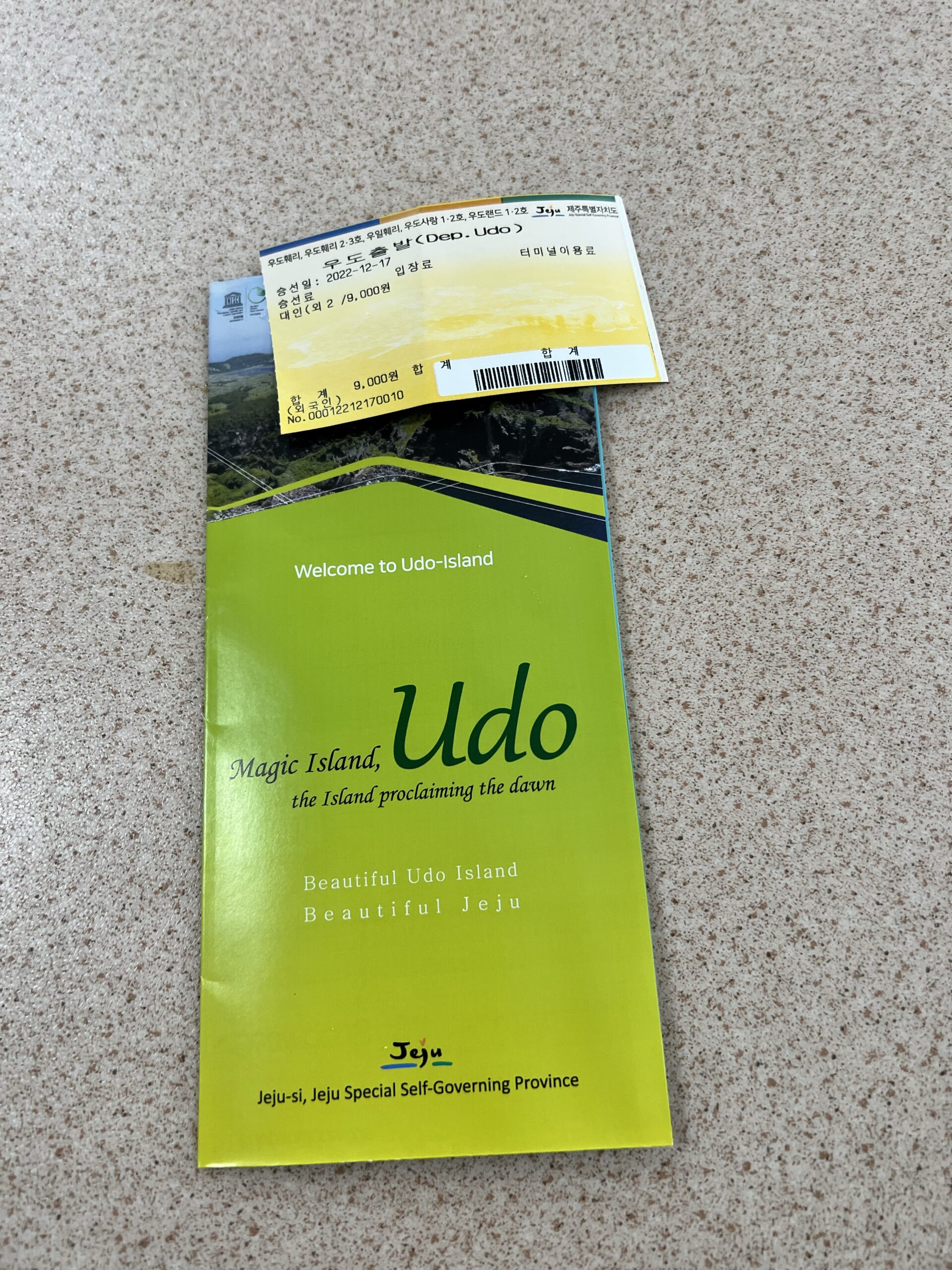
Udo literally translates to Cow Island, with “u” meaning “cow” in the Korean Hanja alphabet (Chinese words used in Korean). It’s named after cows because, apparently, the outline looks like a cow lying down or the top of a cow’s head depending on who you ask.

People started inhabiting and visiting Udo during the Joseon Dynasty when the government built a horse ranch there under King Sukjong in 1697. Regular citizens could visit later under King Heonjong, and Kim Seok Rin, a literary scholar, settled there with his family in 1844. Since then it’s been a fairly popular spot for visitors to Jeju, and it was made an official maritime park in 2000.
In addition to its natural attractions, Udo Island is also home to several small fishing villages, as well as a number of cultural and historical sites. Visitors can explore ancient tombs and temples, as well as traditional Jeju-style houses and museums. The island is also famous for its fresh seafood, which can be enjoyed at a variety of local restaurants and markets.
Guide to Udo Island
There are many things to do and see on Udo Island. Here are some of the top attractions and activities:
- Beaches: Udo Island is known for its beautiful white sand beaches, such as Seobin Baeksa Beach and Haumokdong Beach. Visitors can swim, sunbathe, and enjoy various water activities such as snorkeling, scuba diving, and jet skiing.
- Scenic Views: Udo Island offers breathtaking panoramic views of the surrounding waters and landscapes. You can hike up to the Seobin Hill Observatory or rent a bike to explore the island’s scenic routes.
- Udo lighthouse: One of the most iconic landmarks on Udo Island is the Udo Lighthouse. You can climb up the lighthouse for a stunning view of the ocean and the island.
- Seafood: Udo Island is famous for its fresh seafood. You can enjoy a variety of seafood dishes at local restaurants and markets.
- Culture: Udo Island has a rich cultural history that can be experienced through traditional Jeju-style houses, museums, and ancient tombs and temples.
- Camellia Hill: Camellia Hill is a beautiful botanical garden with over 6,000 camellia trees. Visitors can enjoy a leisurely stroll through the gardens and take in the beautiful scenery.
- Local Markets: There are several local markets on Udo Island, where you can buy souvenirs, handicrafts, and local produce. The most famous one is the Seobin Market, located near the ferry terminal.
How to get to Udo Island
- Go to Seongsan Ilchulbong Peak: The ferry to Udo Island departs from the Seongsan Ilchulbong Peak area on the eastern side of Jeju Island. You can take a bus, taxi or car from Jeju City or Seogwipo to Seongsan Ilchulbong Peak.
- Purchase ferry tickets: You can buy ferry tickets at the Seongsan Ilchulbong Peak ferry terminal or through various travel agencies. The ferry ride takes about 15-20 minutes.
- Board the ferry: Once you have purchased your tickets, board the ferry and enjoy the short ride to Udo Island. Do remember to fill up your passport details on the form, you have to fill in two forms for each person, as one is for going there and the other on the way back. Some people mentioned the checking of passports but for us they did not bother to check.
- Explore Udo Island: Once you arrive at Udo Island, you can rent a bike, a scooter or take a tour bus to explore the island’s attractions. Walking is also possible, but we won’t recommend doing so during summer with the strong winds and cold weather.


Mini electric cars are available for rental once you reach Udo island. There are quite a few of these shops around the island, but they only accept driver’s license from Koreans. These mini cars converted from tuk tuks are very tiny, so they can only fit in two adults. We saw a car that had broken down in the middle of the island and luckily there was a repair shop nearby.






What to do in Udo Island if the weather is too cold and you are hungry? Of course it is time to eat! We found a place near the port and even though it was 11:00 only, we were kinda hungry and ordered some heavy dishes, such as the jjajangmyeon, seafood jjampong and some mandu (dumplings). Everything was so delicious. For the noodle dishes, there was even a generous serving of abalone (two to three pieces each) since we are in Jeju, known for their fresh seafood!



Jeju Island was annexed by Japan in 1910 and remained under Japanese rule until the end of World War II in 1945. During this period, the Japanese government implemented policies that suppressed Jeju’s cultural identity and language and forced local people to work in slave-like conditions in mines and other industries. This is one of the anti-Japanese monument which shows the uprising by the haenyeos.


Biyangdo Island is connected to Udo Island by bridge, and they are separated only by 150 meters of water.
It is easy to find many backpackers and campers here. When we visited, the winds were howling and the waves crashing against the shore, so there were no campers. Most of the shops were also closed as winter is considered low season.

After completing one loop around Udo, it was time to take the ferry back to the mainland. We spent about 4 hours on the island, and it was kind of enough because of the weather conditions. We feel that it is more suitable to visit during summer or autumn, so that you can walk or even rent a bicycle to ride around the whole island. For us, we used the minibus hop on and off ticket to get around the island. Sometimes, we waited 10 minutes for the bus while other times were longer. The driver reminded all the passengers that the last ferry of the day departs Cheonjin port at 15:30 (due to the choppy waves and unpredictable sea conditions) and hoped that no one would miss it, if not they would have to spend the night at Udo Island.

We took the ferry back to the main island of Jeju, and then continued our journey from there.
Costs involved
Ferry tickets: ₩10000 for an adult’s single-day roundtrip ticket
Renting electric bikes: ₩15000 per person to rent an electric bicycle
Minibus with unlimited stops: ₩6000 per person



One Reader Comment on “Jeju Day 3 – trip to Udo Island”
Comments are closed.